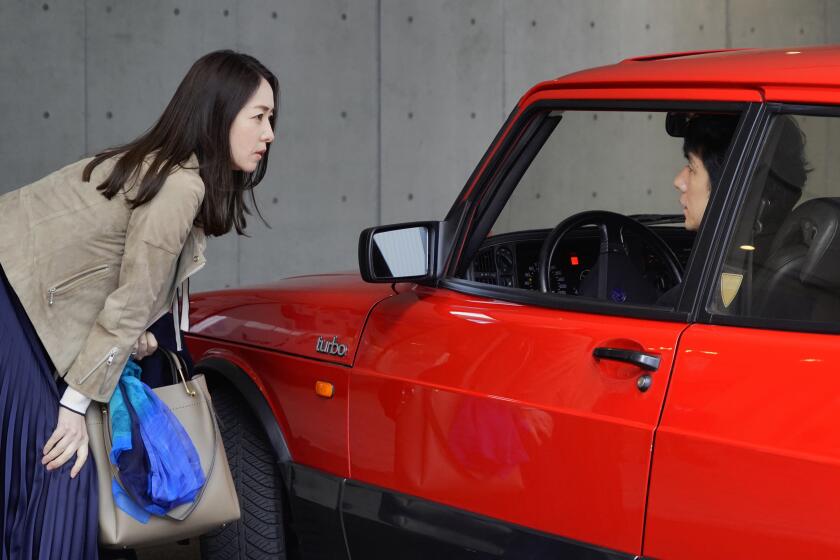How an Indian action icon broke into Hollywood — and the Oscar race — with ‘RRR’
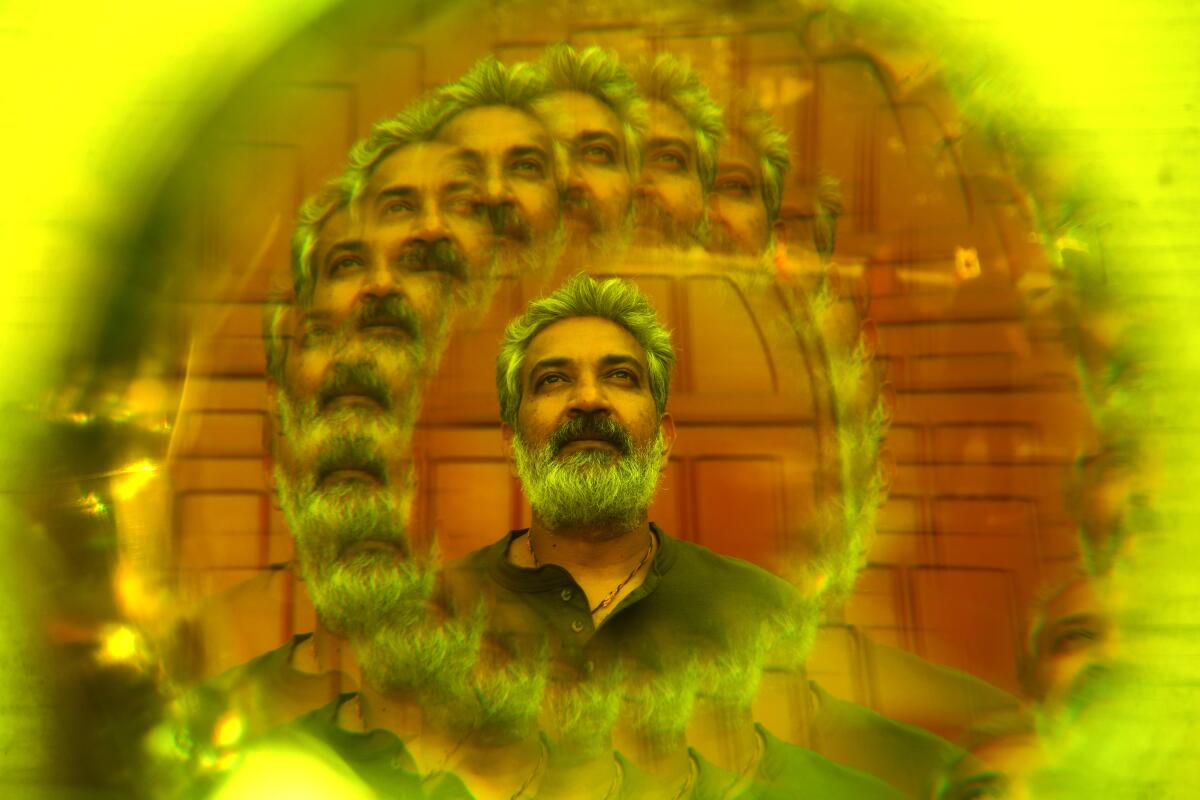
Of U.S. reaction to his film “RRR,” S.S. Rajamouli marvels: “I never, ever would have expected it in my wildest dreams.”
- Share via
S.S. Rajamouli anticipated some applause. Maybe a few whistles from the South Asian viewers he’d spotted in the crowd. The biggest U.S. screening to date of his hit movie “RRR” had sold out in minutes online, but this was Hollywood, not Hyderabad. Would Americans curious about the word-of-mouth hype fall in love with “RRR” as passionately as moviegoers back home?
The veteran director wasn’t sure what to expect as he arrived at the historic TCL Chinese Theatre in late September for an Imax screening of his three-hour period action epic — until a thundering standing ovation greeted him as he introduced the film. Then, as the movie began, so did cheers for actors Ram Charan and N.T. Rama Rao Jr., two megastars of Tollywood, India’s Telugu-language film industry. Before intermission, excited audience members raced to the front of the massive screen to dance along to the the viral “Naatu Naatu” musical sequence. By the closing scene, jubilant fans were jumping out of their seats for every hero moment.
Rajamouli took it all in from the middle of the theater, blown away.
“When I started hearing the roaring laughter and whistles, the shouting, the screaming, people getting up, standing up, showing their love and affection, dancing in front of the stage — my God,” he said the next afternoon, breaking into a wide, serene smile at the firsthand evidence that America had caught “RRR” fever. “I never, ever would have expected it in my wildest dreams.”
An innovative grass-roots effort will bring India’s blockbuster action hit ‘RRR’ back to theaters for one night on June 1.
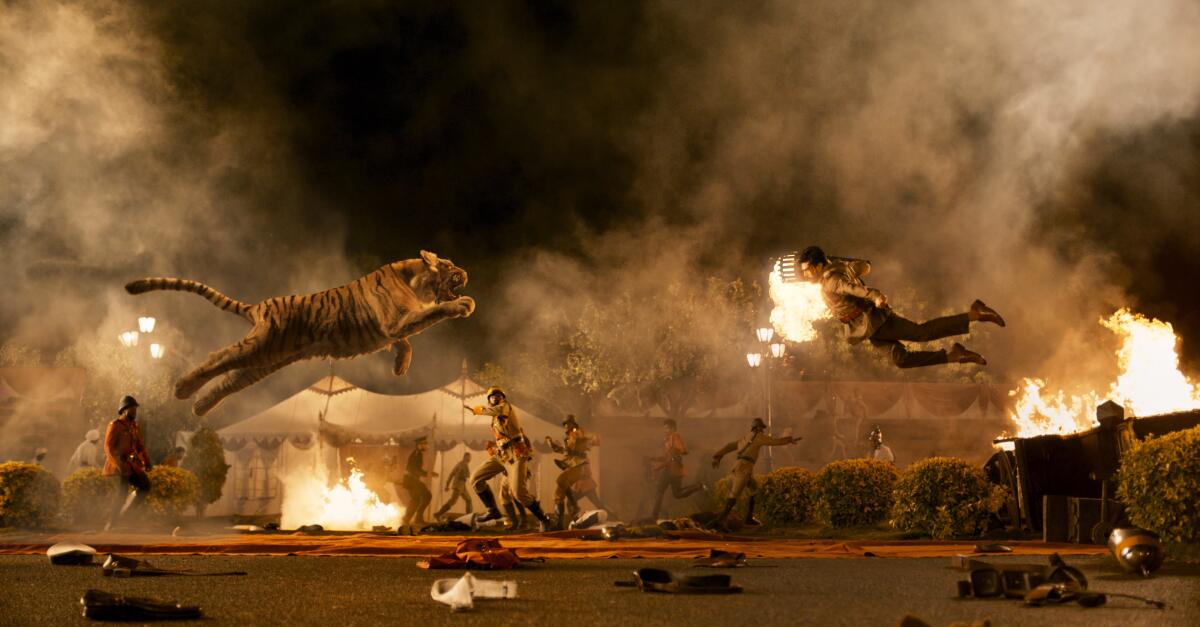
Rise, roar, revolt
“RRR” (short for “Rise, Roar, Revolt”) originated when Rajamouli, 49, took nearly a year off after the success of his previous two-film franchise, the ancient epic “Baahubali: The Beginning” (2015) and “Baahubali: The Conclusion” (2017), each the most expensive and highest grossing Indian film ever at the time of release.
Eager to get back to work, Rajamouli and his screenwriter father, V. Vijayendra Prasad, began developing the 1920s-set two-hander, about an unlikely friendship between freedom fighters. Rajamouli imagined Indian historical heroes Komaram Bheem (played by Rao, a.k.a. Jr. NTR) and Alluri Sitarama Raju (Charan) sharing a fictional macho meet-cute in British-occupied India. Bonded in brotherly love but divided by secret loyalties, they unite to fight the crown in brawny, bombastic battles that wouldn’t feel out of place in a superhero blockbuster or “Fast & Furious” movie.
As a child, Rajamouli was known to spin fantastical, mashed-up yarns for his older cousins. Revisiting the tales of Raju and Bheem, he realized the revolutionaries’ interests overlapped, as did curious gaps in their known histories. “I thought, ‘Here I had my heroes. No one knows what happened to them in these few years,’” Rajamouli said. “‘I’m going to do a story in that space and make them much larger than life.’”
“Even when he was directing television soap operas ... he was a producer’s nightmare,” “Baahubali” producer Shobu Yarlagadda, who has known Rajamouli for decades, said with a laugh. “Because he would want to do something different. Even in that limited environment, with limited resources and time and money, he was experimenting.” (“Never have I thought or had producers or technicians who thought, ‘This is an impossible idea,’” Rajamouli said.)
I said, ‘I’m telling you both at the same time. I have an idea. I want to work with both of you .... Are you interested in working together?’
— S.S. Rajamouli describing his pitch to future ‘RRR’ stars Ram Charan and N.T. Rama Rao Jr.
Rajamouli’s central ambition with “RRR” was to bring together two Tollywood stars to share equal billing, a feat he says hadn’t been attempted in decades. Jr. NTR and Charan, scions of rival filmmaking dynasties whom he had previously directed in separate projects, were the perfect candidates.
To pitch them, he pulled a “Parent Trap,” phoning each to meet at his home. “Outside of this they are friends, but they never expected to see each other at my place,” Rajamouli said. “I said, ‘I’m telling you both at the same time. I have an idea. I want to work with both of you. I’m not even telling you the story. But first, as a concept, are you interested in working together?’”
Filming began in the fall of 2018 in Hyderabad in the southern state of Telangana. By the time “RRR” wrapped, three years and a whopping 320 shooting days later, the production had weathered two COVID interruptions, employed more than 1,000 cast and crew, and established itself as the most expensive Indian film to date. (Press reports have estimated the “RRR” budget at around $70 million, though a producer for the film tells The Times the number is closer to $55 million.)
Rajamouli’s vision, and fan anticipation, built during the pandemic delays. The payoff: “RRR” made a reported $140 million worldwide upon its initial release in March — including $14.5 million on U.S. screens — and became one of India’s highest grossing movies of all time.
Under typical circumstances that might have been the end of the story. But there was an audience for the movie that Rajamouli hadn’t yet imagined.
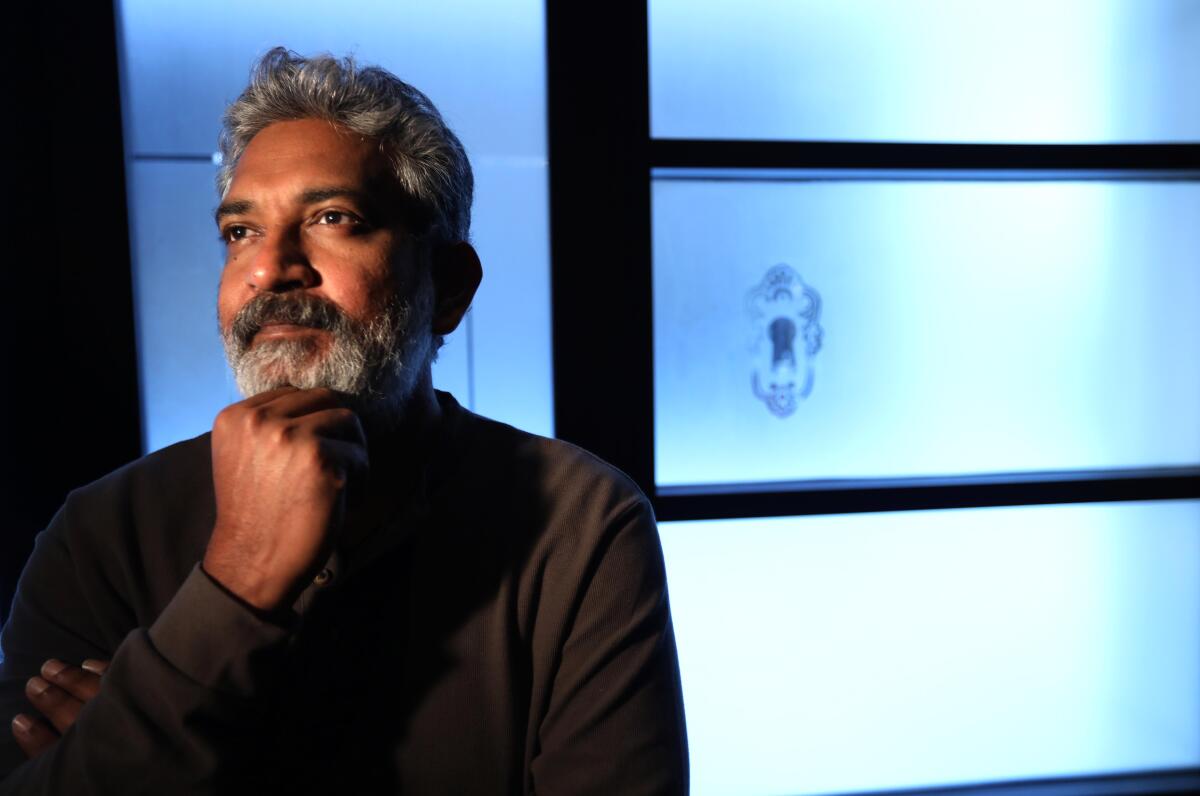
‘Emotion doesn’t have a culture’
Rajamouli, who needs no introduction in India, is sometimes compared to Steven Spielberg or James Cameron, fellow practitioners of large-scale, emotionally driven action, though he has his own unique signature and interests. Something he does share with many of Hollywood’s favorite auteurs is a lifelong love of cinema and the steady diet of ’80s Hollywood action imports he saw at a local theater, where stars like Sylvester Stallone and Arnold Schwarzenegger beefed up the big screen.
“I was in love with films as long as I remember,” he said, sliding into a booth at Westwood’s Tuck Room the day after his Beyond Fest screening at the Chinese. “Until a certain time in my life, I thought all English movies were action movies.”
Mentored by filmmaker K. Raghavendra Rao, Rajamouli started his career as an editor’s assistant before making his directorial debut in 2001 with the romantic action pic “Student No. 1,” starring Jr. NTR. In recent years, with his hit “Baahubali” films, he has spearheaded a paradigm-shifting movement, releasing films in multiple Indian languages and regions, but he remained largely unknown outside of Indian and action film circles until “RRR,” with its charismatic leads and breathtaking “how’d they do it” set pieces, took worldwide cinemas by storm.
Early this summer, months after initial release, a grassroots effort to bring “RRR” back to U.S. theaters to wider audiences coincided with its global Netflix debut in Hindi. The film’s profile blew up, driven by social media fervor.
Now firmly established as a crossover success, “RRR” is eyeing a goal that was never part of the plan: the Academy Awards.
L.A.’s Beyond Fest’s monthlong celebration of ‘RRR’ director S.S. Rajamouli to include rare screenings, a career retrospective and in-person Q&A.

“It’s exciting and intimidating all at once,” Rajamouli said of the film’s dark horse awards campaign, which officially launched last month. An L.A. Times Oscars BuzzMeter poll of experts has “RRR” in the top 10 running for director and picture. As he spoke, awards voters at the iPic theater in Westwood watched the film ahead of an early-season reception, while in Santa Monica, a packed audience at the Aero was marathoning three of his earlier films as part of his first U.S. career retrospective.
Typically, when a movie of Rajamouli’s opens, he will slip into a theater more than 30 times to learn how different audiences respond throughout the film. Something “RRR” proved was that moviegoers around the world can connect to his films even absent specific cultural context, such as the setting’s history or politics.
“I don’t think you need to explain to the audience what culture is. I don’t think you can, in a film,” he said. “If you find compelling characters and compelling incidents, you are instantly drawn in, and for things that you don’t understand, the mind automatically makes its own story. I don’t think Western audiences, or any audience for that matter, are watching the film exactly the way I’m intending them to.”
What’s important, said Rajamouli, is that the emotion connects with the viewer. “Emotion doesn’t have a culture. The expression of love changes, but the relation itself doesn’t change. It’s the same across all human beings. ... If I analyze why I like action, it’s that action enhances emotion, and emotion makes action look good.”
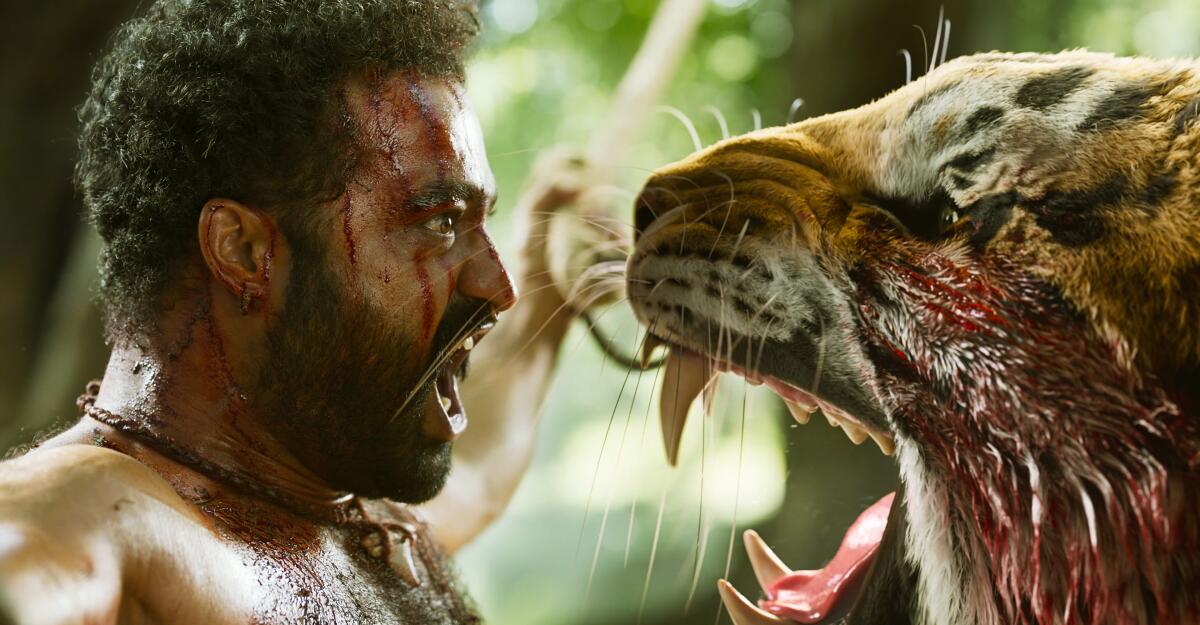
The Oscar push
During Rajamouli’s dizzying week and a half in L.A., “Flashdance” star Jennifer Beals was one of many fans who came out to meet the director. “I thought, if this person is alive on Earth and I have the opportunity to give them my gratitude, then I have to go do that,” Beals, who would later host her own screening of “RRR,” told The Times. “It’s over three hours long, but you’re wishing it was three more hours. I want to see it over and over again, and now I feel sort of evangelical about it.”
She’s not alone. Prominent “RRR” champions now include the Russo Brothers, new DC Studios co-head James Gunn and “The Black Phone’s” Scott Derrickson, who called it “an awesomely outrageous roller coaster of a movie,” illustrating the sentiment in a tweet with a GIF of Jr. NTR slo-mo knee-sliding out of the reach of a leaping tiger, surrounded by a wall of flames.
Action enhances emotion, and emotion makes action look good.
— S. S. Rajamouli
Following a trip to Japan in October, where “RRR” enjoyed a record-breaking opening, Rajamouli is now embarking on a multicity U.S. tour with more awards-focused Q&As to come, including a two-day Thanksgiving “residency” at the Crescent Theater in Beverly Hills. And while India declined to select the film as its international Oscar entry, no matter: “RRR” has bigger targets in sight as its FYC campaign advocates for nods including best picture, director, VFX, score and acting categories for both Jr. NTR and Charan.
Dylan Marchetti of specialty distributor Variance Films, who helped guide Japan’s “Drive My Car” to an Oscar last year, also launched the “RRR” rerelease and awards push. “What we’re trying to do is let the film speak for itself,” he said. He expressed optimism about the academy’s recent efforts to diversify the Oscars, which awarded Korean thriller “Parasite” four awards in 2020, including best picture. Inviting Jr. NTR and Charan to participate in the telecast wouldn’t hurt ratings, either, he added: “I know there’s an awful lot of people in India who would love nothing more than to see those guys up on stage.”
Moments before voters streamed out to greet him, Rajamouli marveled at the appreciation North American audiences have shown for his actors. “I have seen so many people react to these two stars and they’re saying, Ram Charan is so handsome, Tarak [Rao] has such expressive eyes,” he said, beaming. “They never, ever say ‘this Indian star.’ That says, I think, the Western audiences are ready to receive them in many, many more avatars than just ‘RRR.’”
From Oscars going back to the Cannes Film Festival, ‘Drive My Car’ took a slow but steady route to surprise awards glory.
‘I have to be there’
Traveling the U.S. with “RRR,” Rajamouli learned how the film, his 12th feature, penetrated U.S. film culture. And he pondered more closely how Hollywood’s way of moviemaking, with much shorter schedules and multiple filming units, differed from his own.
A meticulous storyboarder, Rajamouli says he and his team create extensive animated previsualizations after charting out the details of each hero moment, down to the direction that a character’s hair might be blowing in the wind. He also breaks his script into “episodes” that are individually prepped and shot before moving on to the next block and starting the process again.
To achieve the staggering stunt sequence that opens “RRR,” for example, in which Charan’s Raju single-handedly fights his way through a mob of several hundred adversaries, production spent 10 days prepping and 20 days filming with director of photography K.K. Senthil Kumar, using the Imax-certified Arri Alexa LF. The final “episode,” capturing the “Naatu Naatu” dance sequence, took place at Mariinsky Palace in Kyiv, Ukraine, in 2021.
Rajamouli, who counts Cameron’s “Terminator 2: Judgment Day” and Mel Gibson’s “Braveheart” among his favorite films, prefers to direct every shot hands-on, rather than rely on additional filming units. “I need to see what’s happening,” he said with a laugh. “The action sequences are my favorite. I have to be there. The dance sequences are my favorite. I have to be there. The performances are where the story is being built. I have to be there.”

The specificity has made him wonder how easily he would transition into a Western way of working, although he isn’t ruling it out. He would like to work with a Tom Cruise-type star one day, if the story was compelling enough. “I would love it. It’s not that I wouldn’t like to do it, but maybe in the future — at present, I don’t think so.”
Rajamouli, who signed with Creative Artists Agency in September, is in no hurry to make films outside of his home country. “I like telling stories about India,” he said. “If people from other countries, other cultures, other languages come to know something about India through my films, I feel great about it. But that is not the intention that I started with. That is a byproduct.”
An “RRR” sequel is in early development with his father, but it won’t be Rajamouli’s next project. Someday, he said, he also hopes to adapt the Sanskrit epic “Mahabharata” in his own style, a dream project he’s been teasing for years.
Until then, he has the same persistent goal: “To keep telling stories,” said Rajamouli. “If that is a goal, then every day I have that goal.”
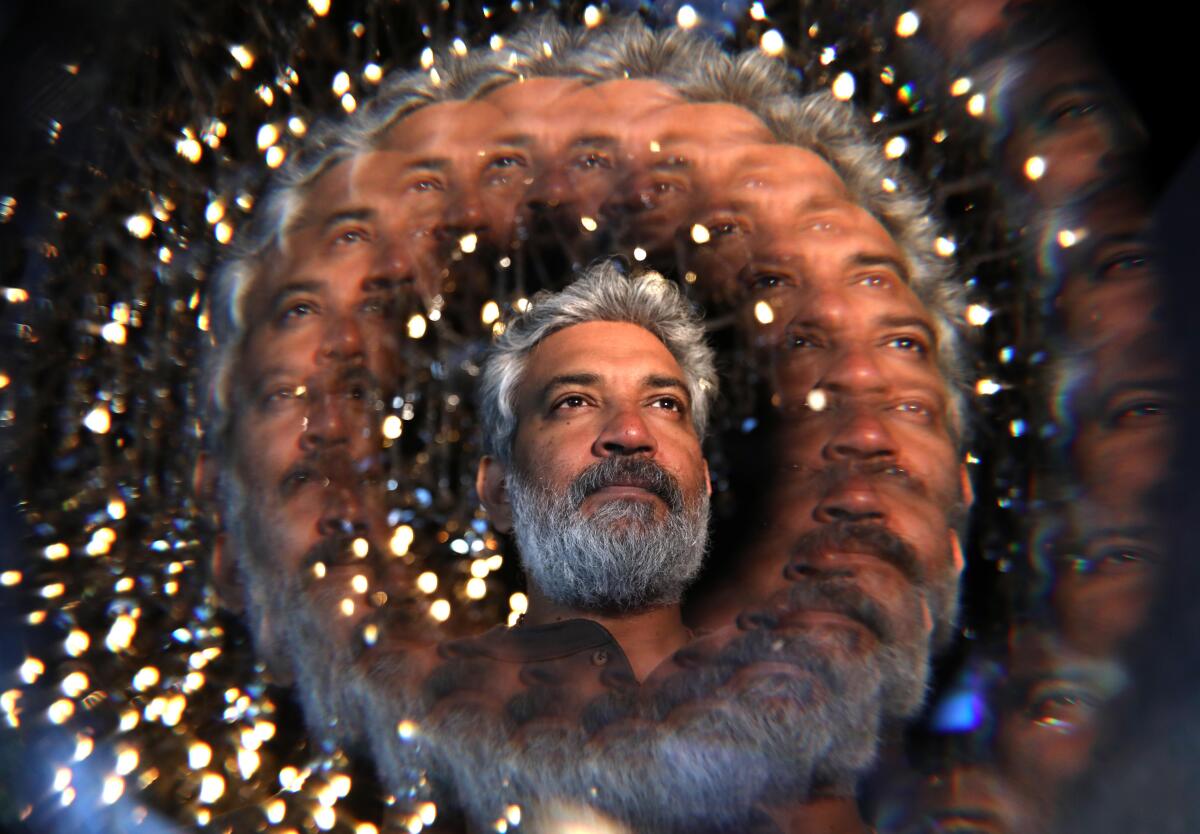
More to Read
Only good movies
Get the Indie Focus newsletter, Mark Olsen's weekly guide to the world of cinema.
You may occasionally receive promotional content from the Los Angeles Times.


